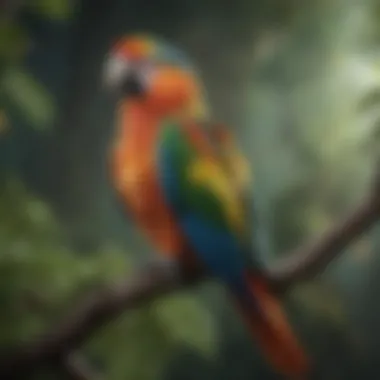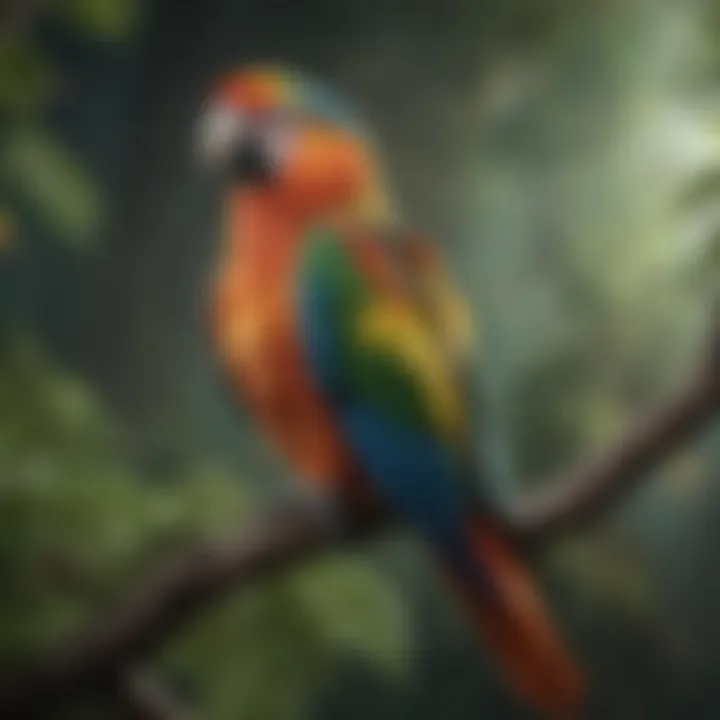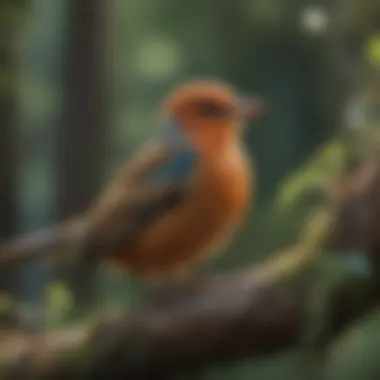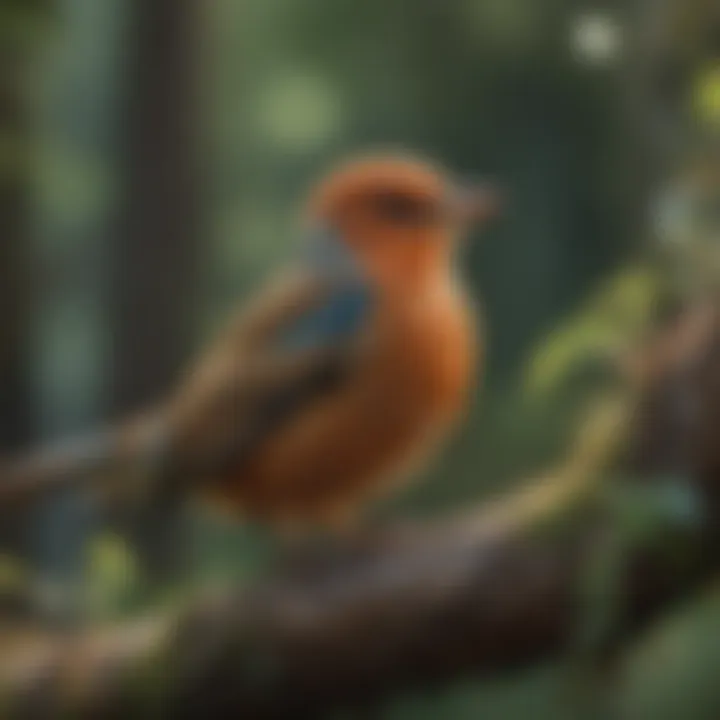The Life Span of Birds: Insights into Longevity


Intro
Understanding the life span of birds is more than academic curiosity; it is essential for pet owners, animal lovers, and families seeking to enhance the quality of life for their feathered companions. Birds can exhibit remarkable longevity, but their potential life expectancy varies widely across species. Factors such as genetics, diet, environment, and social interactions play crucial roles in determining how long these creatures live. This article explores these themes systematically, shedding light on the intricacies of avian longevity and survival.
Understanding Your Pet
Pet Behavior Basics
Birds, as pets, often display behaviors that are intrinsic to their species. Understanding these behaviors helps pet owners create nurturing environments that mimic natural stimuli. For instance, many species demand social interaction, as they are inherently flock animals. Observing your bird's daily activities can provide insights into their emotional well-being.
Common Breed Characteristics
Certain breeds exhibit unique traits that affect their care. Parakeets, for example, are known for their sociable nature, requiring ample interaction. Cockatoos, on the other hand, are intelligent and may develop separation anxiety if left alone for extended periods. Recognizing these differences is crucial when selecting a pet bird, ensuring that potential owners can meet their needs.
Species-Specific Needs
Each bird species has distinct requirements related to diet, habitat, and socialization. Larger species like macaws need more space and varied diets to thrive. On the contrary, smaller birds like finches may require less room but still benefit from social interactions. Understanding these species-specific needs can lead to better health outcomes and enhanced longevity.
Pet Care and Maintenance
Feeding Guidelines
Proper nutrition forms the backbone of a bird’s health. Seeds are generally not enough; many species thrive on a balanced diet that includes fruits, vegetables, and specially formulated pellets. It’s essential to consider their natural diets for optimal nutrition, enriching their meals with fresh produce to support their longevity.
Grooming Essentials
Regular grooming is essential for a bird's physical health. Cockatiels require regular beak and nail trims, while budgies may benefit from occasional feather clipping. Maintaining a routine helps prevent health issues and supports overall well-being, which in turn can extend longevity.
Hygiene Practices
Hygiene is often overlooked but vital for bird care. Regular cage cleaning and sanitizing are necessary to prevent diseases. Ensuring clean water is available at all times is equally important, as hydration impacts overall health.
Training and Development
Basic Commands and Skills
Training birds can be a rewarding experience. Basic commands like “step up” or “come here” not only enhance communication but also foster trust. Consistent, gentle reinforcement leads to long-term behavioral improvements, enhancing the bond between the bird and its owner.
Behavioral Training Techniques
Behavioral issues can arise if birds are not properly socialized. Positive reinforcement techniques can address problems such as biting or screaming. Establishing routines and using treats can help guide birds toward desired behavior.
Addressing Common Behavior Issues
Understanding and tackling behavior problems is key to a harmonious environment. Issues like feather plucking can indicate stress or lack of stimulation. Identifying the root cause is essential for developing effective strategies to mitigate these problems.
Health and Wellness
Routine Vet Check-ups
Regular veterinary check-ups are crucial for early detection of health issues. Birds often hide symptoms until conditions worsen, so routine exams help maintain health. Vaccination against common diseases is also beneficial in ensuring longevity.
Vaccination Needs
Many common bird species may require vaccinations to prevent infectious diseases. Researching specific needs based on species is essential to maintain health and well-being.
Recognizing Signs of Illness
Bird owners should be vigilant about recognizing signs of illness. Changes in behavior, appetite, or droppings often indicate health problems. Education about common signs can guide swift interventions, which is critical in avian care.
Enrichment and Activities
Indoor vs. Outdoor Activities
Providing a mix of indoor and outdoor activities is important for mental stimulation. While outdoor exposure needs careful supervision to ensure safety, indoor activities can include toys and puzzles that challenge a bird's intellect.
Interactive Toys and Games
Interactive toys are beneficial for keeping birds engaged. Items that encourage foraging or problem-solving can reduce boredom. A stimulated bird is less likely to develop behavioral issues, supporting better health outcomes.
Socialization Opportunities
Socialization is vital for a bird's mental health. Spending time with other birds or with humans enhances the overall well-being and can lead to a longer life. Finding ways to introduce social experiences is key for a pet bird’s development.
Prelims to Bird Lifespan
Understanding the lifespan of birds is critical for many reasons. This topic dives into the complexity of avian life, revealing factors that can determine how long these creatures live. Lifespan is not just a number; it reflects the overall health and well-being of bird species. Knowing this can help pet owners make informed decisions to foster healthier, longer lives for their avian companions.


Understanding Avian Longevity
Avian longevity varies greatly among species. While small birds might live only a few years, larger birds such as parrots can reach ages exceeding fifty years. This variation often stems from a combination of genetics, environmental factors, and lifestyle choices. For example, finches typically have a shorter lifespan compared to cockatoos, which can thrive for decades. The increase in lifespan in larger birds is commonly attributed to fewer natural predators and a more robust genetic framework.
Often, behavioral traits also influence longevity. Birds that show curiosity and engage with their environment may have a higher chance of living longer. Moreover, it's essential to recognize that lifespan is not solely dependent on race or species. For instance, captive birds usually live longer than their wild counterparts due to reduced predation and controlled environments. This phenomenon highlights the importance of understanding the needs and behaviors of different bird species when discussing their potential lifespans.
Importance of Lifespan in Bird Care
For those caring for birds, awareness about their lifespan is invaluable. Knowing the expected lifespan can help inform care practices and create a supportive environment. Longer lifespans in pet birds often mean that owners must consider long-term commitments. This involves regular veterinary visits, a balanced diet, and mental stimulation.
Furthermore, understanding lifespan aids in preparing for various life stages. Different care requirements can emerge from hatchling through juvenile to adult stages. Each phase presents unique challenges and opportunities to ensure birds thrive. In addition, social interactions are crucial; birds that remain isolated or lack stimulation may show shorter lifespans. Having companion birds can mitigate this risk, reducing stress and promoting overall well-being.
"Lifespan differs widely among bird species, but attentive care can significantly enhance avian health."
Factors Affecting Bird Lifespan
Understanding the factors that influence the lifespan of birds is vital for bird owners and enthusiasts. These elements shape how long a bird can thrive, both in the wild and in captivity. Genetic predispositions, environmental conditions, and dietary habits all play a significant role in determining longevity. A comprehensive grasp of these factors allows bird keepers to enhance care and tailor habitats according to specific needs.
Genetic Influences
Genetics form the backbone of avian lifespan. Many bird species have evolving traits that dictate their life expectancy. For instance, larger birds such as parrots and eagles typically have longer lifespans than smaller birds like finches or sparrows. This correlation arises from the different metabolic rates and energy requirements among species.
Moreover, purebred birds may have distinct health challenges or advantages linked to their genetic background. For example, certain breeds like the African Grey parrot are known for their intelligence but are also prone to specific genetic disorders. Recognizing these genetic influences can help bird owners anticipate potential health issues and pursue preventative measures.
Environmental Conditions
The environment in which a bird lives directly affects its lifespan. Birds in the wild face numerous hazards, including predation, habitat destruction, and climate change. Urban areas can offer challenges like pollution and reduced natural habitats, negatively impacting bird health.
In captivity, an enriched environment is crucial. Access to clean air, appropriate space, and mental stimulation can lead to enhanced well-being. Here are some key environmental considerations:
- Habitat Quality: Well-maintained cages with room for movement enhance bird satisfaction and health.
- Social Interaction: Birds are social creatures; isolation can lead to stress and behavioral problems, undermining longevity.
Diet and Nutrition
Proper diet is fundamental to a bird's health and longevity. Nutrition varies significantly across species. A well-balanced diet tailored to the specific needs of a bird species can prevent various health issues. Commonly, birds require a mix of seeds, grains, fruits, and vegetables.
Particularly, here are some dietary considerations:
- Seed-based Diets: While birds may enjoy seeds, relying solely on them can lead to obesity and deficiencies.
- Fresh Fruits and Veggies: These should be integrated as they provide essential vitamins and minerals crucial for overall health.
- Commercial Pellets: High-quality formulated pellets ensure that birds obtain all necessary nutrients.
Comparative Lifespans of Bird Species
Understanding the comparative lifespans of various bird species is crucial for bird enthusiasts and pet owners. Different species exhibit markedly different lifespans, influenced by factors such as size, habitat, and domestication. By examining these variations, one can better grasp the particular needs and care requirements of specific birds, ensuring a more informed approach to avian husbandry. Additionally, this knowledge aids in conservation efforts by highlighting the challenges faced by endangered species with shorter lifespans.
Small Birds versus Large Birds
Small birds generally have different life expectancy compared to their larger counterparts. For instance, species like the Bengalese finch or canary, typically smaller in size, often have a lifespan ranging from five to ten years. In contrast, larger birds such as macaws can live for 50 years or more in captivity.
Factors contributing to these differences include metabolic rates, predation risks, and breeding practices. Higher metabolic rates in smaller birds can lead to faster aging processes.
- Small Birds:
- Large Birds:
- Lifespan: 5-10 years
- Examples: Budgerigar, Zebra Finch
- Care Needs: Regular veterinary check-ups, supportive environments
- Lifespan: 30-80 years
- Examples: African Grey Parrot, Hyacinth Macaw
- Care Needs: Extensive space, social interaction
Wild Versus Domesticated Birds
The differences between wild and domesticated birds in terms of lifespan are significant. Wild birds face numerous hazards, including predators, food scarcity, and climate variations, which can drastically limit their life expectancy. For example, a wild sparrow might live for only a few years, while domesticated varieties might live much longer due to reduced risks and better care.
- Wild Birds:
- Domesticated Birds:
- Lifespan: Generally shorter, often due to predation
- Survival Factors: Natural diets, environmental threats
- Lifespan: Typically longer, around 10-30 years
- Reasons: Controlled environments, regular feeding, minimal predation
Endangered Species and Lifespan
Endangered species present a complex picture regarding lifespan. Many endangered birds face drastic environmental changes and habitat loss, impacting their survival and reproductive rates. For instance, the California Condor has a longer potential lifespan but has seen dramatic declines due to habitat destruction and lead poisoning.
Understanding the lifespans of these species can guide conservation strategies. For example, efforts focused on habitat restoration and reducing human impact are essential to improve their life expectancy as well as their populations.
"A species' lifespan is often a reflection of its ecological niche and survival strategies."
By acknowledging these aspects of comparative lifespans, we can foster a more empathetic understanding of bird care and conservation, ultimately enhancing our efforts to protect avian life.
Common Pet Birds and Their Lifespans


Understanding the lifespans of common pet birds is key for owners and enthusiasts. Pet birds often have different lifespans compared to their wild counterparts.
These differences may be due to genetics, diet, and living conditions. By knowing the lifespan of various bird species, pet owners can tailor care to extend their birds’ lives. It is essential to recognize the needs of specific species, ensuring their habitat and diet meet optimal standards. This section will explore three popular pet bird species: Budgerigars, Cockatiels, and Canaries.
Budgerigars
Budgerigars, commonly known as budgies, are small and colorful birds. Their lifespan generally ranges between 5 to 10 years, although some may live longer with proper care. One of the main factors contributing to their longevity is a balanced diet. Budgies thrive on a mix of seeds, fruits, and vegetables.
Providing fresh water and regular veterinary check-ups also plays a vital role in their health. Social interaction is crucial; having a companion budgie can reduce stress and promote better well-being. A spacious cage, along with toys, can enhance their quality of life.
Cockatiels
Cockatiels are known for their friendly nature and beautiful crests. Their lifespan typically falls between 10 to 14 years, although some may live even longer with attentive care. Diet is again a significant factor. A diet comprising high-quality pellets, seeds, and fresh vegetables is necessary for their health.
Cockatiels thrive on social interaction. Regular interaction with their owners minimizes loneliness, which increases their happiness. Their environment should be enriched with various perches and play items to sustain their mental stimulation. Regular health checks further ensure they stay healthy and active.
Canaries
Canaries are delightful songbirds, usually living around 10 to 15 years. Their specific needs are different from budgies and cockatiels. A suitable diet includes seeds, vegetables, and fruits. Canaries should be kept in an adequate cage size to allow for movement but are often solitary. Unlike social birds, canaries may not require constant interaction.
Providing a spacious cage with ample nesting materials is essential for their comfort. It is crucial to pay attention to their singing habits as changes might indicate health issues. Regular check-ups will help catch any health problems early.
"Understanding the specific lifespan and care needs of pet bird species helps ensure better health and happiness of your avian companions."
By focusing on the individual needs of Budgerigars, Cockatiels, and Canaries, pet owners can create an enriching environment conducive to longevity. Mastering their diets, social needs, and habitat will lead to prolonged, healthier lives for these cherished companions.
Life Cycle Stages of Birds
Understanding the life cycle stages of birds is critical to grasping their lifespan and survival strategies. Each stage - hatchling, juvenile, and adult - represents distinct challenges, developmental changes, and care requirements. Recognizing these stages allows pet owners and bird enthusiasts to provide optimal care tailored to the specific needs of birds as they grow. This awareness ultimately contributes to enhanced health and longevity for our feathered companions.
Hatchling Stage
The hatchling stage marks a vulnerable period in a bird's life. After hatching, chicks are typically dependent on their parents for food, warmth, and protection. They are born blind and featherless, making them highly susceptible to predators and environmental stresses. This dependency is crucial, as it influences the development of social behaviors and survival skills later in life.
During this stage, the care provided by the parent birds is essential. High-quality nutrition is important for the rapid growth they experience. Factors such as temperature and humidity play a key role in survival rates, as hatchlings cannot regulate their body temperature independently. In homes with pet birds, understanding this stage, especially for hatchlings, helps owners recognize the requirements for a successful transition into the next phase of life.
Juvenile Stage
At the juvenile stage, birds start to develop their independence. They begin to grow feathers, learn basic flight skills, and explore their surroundings. This stage is marked by significant behavioral changes, as young birds often engage in play and practice flying. This is essential for building muscle strength and coordination, which are vital for survival as adults.
In a domestic setting, juvenile birds require a properly enriched environment to promote cognitive and physical development. Providing toys and opportunities for social interaction is important. Attention to nutrition continues to be necessary during this time, as young birds need a balanced diet to support their growing bodies. Any gaps in their care during this stage could have lasting impacts on their overall longevity.
Adult Stage
The adult stage signifies a bird’s entry into reproductive maturity and independence. Adult birds are typically more robust, having developed skills necessary for foraging and defending their territories. They play a significant role in the ecosystem, often as foragers, pollinators, or seed dispersers, depending on their species.
For pet birds, this stage can present both benefits and challenges. Adults often require careful management of their diet, exercise, and social interaction to avoid health issues such as obesity or behavioral problems. Knowing how to engage an adult bird is key to maintaining its mental stimulation and overall well-being.
Understanding each of these three stages provides insights into the overall life cycle of birds. It emphasizes the importance of appropriately timed care and the necessity of adaptations to improve health and longevity in both wild and domesticated settings.
"Comprehending the life cycle stages of birds is not just academic; it is fundamental to nurturing and ensuring their longevity."
Through awareness of these developmental phases, pet owners can manage their birds’ habitats better, thus fostering a healthy environment and supporting a fuller, longer life.
Health Care and Lifespan Extension
Health care plays a crucial role in extending the lifespan of birds, affecting their overall health and well-being. Proper care not only ensures a longer life but also improves the quality of life. Pet owners should recognize that birds require special attention to their physical and emotional health.
Regular Veterinary Check-Ups
Regular veterinary check-ups are essential for monitoring a bird's health. These visits help in identifying potential health issues before they become serious. Just like human beings, birds may exhibit subtle changes in behavior or health that may go unnoticed by their owners. Routine examinations enable the veterinarian to assess nutritional needs, check for diseases, and ensure vaccinations are up to date.
In addition, a veterinarian may recommend a specific diet based on the bird’s species and age, which can significantly influence their longevity. Regular check-ups can be seen as part of a proactive approach to avian health care. Establishing a relationship with an avian vet early in your bird's life can lead to better health outcomes.
Vaccinations and Preventive Care
Vaccinations are an important aspect of preventive care in birds. They protect against various diseases that can significantly shorten their lifespan. Common vaccinations include those for psittacosis and avian influenza. Awareness of these diseases and following a vaccination schedule laid out by a veterinarian can drastically improve your bird's chance of living a longer life.
Preventive care also extends to other aspects such as nutritional balance and mental stimulation. Ensuring that your bird eats a varied diet rich in vitamins and minerals can prevent many health issues. Keeping the environment clean and stress-free also helps in minimizing health risks.
Importance of Socialization
Socialization is often underestimated but is critical for a bird's mental health. Birds are social creatures and need interaction for their cognitive development. Lack of social interaction can lead to stress, resulting in behavioral issues and potential health problems.
Pet owners should engage with their birds regularly, providing them with social opportunities. It can include interacting with other birds or allowing them to play in safe, supervised environments. Learning to read their body language and vocalizations can also enhance the bond, making them happier and more content.
"A healthy bird is a happy bird!" Regular interaction paired with medical care can significantly enhance a bird's quality of life.


By focusing on these elements—regular check-ups, vaccinations, preventive care, and socialization—pet owners can help extend the lifespan of their birds significantly. Being attentive to their needs not only fosters a thriving environment but also nurtures the bond between the pet and the owner.
Behavioral Aspects Affecting Lifespan
Understanding the behavioral aspects that influence bird lifespan is essential for all bird enthusiasts and pet owners. Birds, like many other animals, exhibit behaviors that directly impact their longevity. These behaviors include stress levels, social interactions, and mental stimulation, all of which play significant roles in their overall health and well-being. A deeper insight into these elements provides valuable knowledge for enhancing the care of birds in captivity and the wild.
Stress and Its Implications
Stress is a critical factor affecting the health of birds. Just like humans, birds can experience stress from various sources. These sources may include loud noises, changes in their environment, lack of socialization, or even improper handling. Elevated stress levels can have detrimental effects on a bird's immune system, making it more vulnerable to diseases.
Key points on stress implications in birds:
- Chronic Stress: Birds that experience ongoing stress may develop chronic health issues such as feather picking, weight loss, and digestive problems.
- Behavioral Changes: Stress can lead to changes in behavior, including increased aggression, withdrawal from social interactions, or vocalization issues.
- Healthy Environment: A stress-free environment should include a safe and familiar space, consistent routines, and minimal disturbances. All these factors are pivotal to maintain avian health.
"A calm environment allows birds to thrive and live longer, healthier lives."
Cognitive Engagement
Cognitive engagement is vital for the mental health of birds. This engagement fosters their emotional well-being and can be a significant contributing factor to their lifespan. Birds, particularly those kept as pets, require mental stimulation to keep them active and healthy.
Ways cognitive engagement impacts lifespan include:
- Problem-Solving Activities: Toys that require problem-solving can provide essential mental stimulation. Items like foraging toys challenge birds and keep them engaged, promoting long-term health.
- Social Interaction: Being socially engaged with humans and other birds can enhance their mood and reduce feelings of isolation, which can improve overall life expectancy.
- Learning Opportunities: Birds that are encouraged to learn new skills or tricks tend to be more active mentally. This activity can result in a more fulfilled life and can reduce the instances of destructive behaviors.
Environmental Enrichment for Birds
Environmental enrichment plays a significant role in the longevity and well-being of birds. It refers to enhancing their living conditions to promote their physical and psychological health. Creating a stimulating environment is crucial for birds, whether they are in captivity or the wild. Engaging a bird’s mind and body can help reduce stress and prevent behavioral issues. This can lead not only to a happier pet but potentially a longer life.
Importance of Space and Habitat
Space is an essential component of environmental enrichment for birds. In captivity, a lack of sufficient space can lead to stress and frustration. Birds that feel cramped may resort to destructive behaviors or develop health issues. It is important to provide enough room for birds to stretch their wings and move freely. An ideal habitat mimics natural conditions as much as possible. This could include different levels for climbing, areas to fly, and proper perches.
When assessing the habitat, consider:
- Size: A larger cage allows for more natural behavior. Birds can have multiple perches and toys, which reduces monotony.
- Variety: A space that includes different textures and surfaces can encourage exploration and activity. Different heights can cater to their need to perch above ground.
- Privacy: Birds also appreciate places to retreat when they feel stressed. Providing hiding spots can help them feel safe.
Toys and Interactivity
Toys serve as vital tools for environmental enrichment. They stimulate a bird's natural instincts, encouraging play and exploration. Toys can help prevent boredom, which is a significant cause of stress in birds. Different toys can have various impacts:
- Chewing Toys: These satisfy a bird's natural urge to chew. They keep beaks healthy and help to prevent unwanted behaviors.
- Foraging Toys: These encourage birds to search for food, mimicking how they would behave in the wild. They promote mental engagement and can extend feeding time, making meals more exciting.
- Interactive Toys: Toys that require the bird to manipulate them to receive a reward are useful for mental stimulation. They can help keep a bird active and engaged, which is important for both psychological and physical health.
In summary, enriching the environment of birds is key to improving their quality of life. Providing adequate space and suitable toys will not only enhance their happiness but also contribute to their lifespan.
The Role of Habitat in Longevity
The habitat in which birds live plays a critical role in their overall lifespan and health. Various environmental factors contribute to how long a bird may live, making the understanding of these habitats essential for both avian enthusiasts and pet owners. Habitats can influence food availability, safety from predators, and stress levels, all of which are crucial to a bird’s longevity. In this section, we will explore how natural habitats correlate with lifespan and how urban environments compare to rural settings.
Natural Habitats and Lifespan Correlation
Natural habitats, such as forests, wetlands, and grasslands, provide essential resources for birds. These areas are often rich in biodiversity, offering a variety of food sources and nesting sites. For example, the Amazon rainforest supports countless avian species, many of which have longer lifespans due to the abundance of food and nesting materials. Birds that can find shelter and food easily in their natural surroundings tend to have reduced stress, which positively impacts their health and life expectancy.
Studies show a correlation between habitat quality and bird longevity. Birds in well-preserved environments where they can thrive are likely to live longer than those in compromised habitats. A study by ornithologists indicates that species such as the American Robin may live significantly longer in forested areas where they can find their diet more readily, compared to urban settings with limited natural resources. Factors such as climate, weather patterns, and the presence of other wildlife also affect the lifespan of birds in their habitats.
"The quality of a bird’s habitat is linked directly to its health and longevity, highlighting the importance of conservation efforts."
Urban vs Rural Environments
The contrast between urban and rural environments significantly impacts bird longevity. Urban areas often present challenges such as pollution, limited access to natural food sources, and noise, all of which contribute to stress and lower life expectancy among birds. For example, pigeons in cities may face high competition for scraps and habitat space. Studies show that urban pigeons can show higher levels of stress hormones, which can lead to health issues and reduced lifespans.
On the other hand, rural areas typically feature more natural landscapes with abundant food sources and fewer threats from humans. Species like the meadowlark thrive in these environments, enjoying longer lives due to less disturbance and better living conditions. However, rural birds may face other challenges, such as predation from wildlife, which can impact their longevity.
Culmination
Understanding the lifespan of birds is crucial for both bird enthusiasts and pet owners. This conclusion synthesizes the key insights presented throughout the article, emphasizing significant elements and benefits related to avian longevity.
The information provided helps in addressing several considerations, such as the unique factors that influence the lifespan of various bird species. Recognizing the differences between wild and domesticated birds sheds light on how various environments contribute to longevity. Ensuring proper care, including diet and habitat, can make a significant difference in the lifespan of pet birds.
"The choices made in their living conditions can directly impact their health and lifespan."
By comprehending these dynamics, caregivers can create optimal environments for their birds, promoting longer lives and better overall health. This is especially beneficial not only for maintaining the physical well-being of birds but also for enhancing their emotional and behavioral health.
Key Takeaways
- Lifespan Variations: Different species exhibit distinct lifespans influenced by genetics, environment, and care practices.
- Impact of Habitat: The natural habitat and quality of the environment, whether urban or rural, greatly affect bird longevity.
- Health Care is Vital: Regular veterinary care and social interaction play an essential role in prolonging the life of pet birds.
- Diet and Nutrition: Providing a balanced diet is crucial for promoting health and increasing lifespan.
- Cognitive Engagement: Keeping birds mentally stimulated can prevent stress, which otherwise shortens their lifespan.
Future Considerations for Bird Care
As we reflect on the information gathered, it is important to consider the future of bird care and how knowledge can evolve. Potential areas for further exploration include:
- Research Advancements: Ongoing studies may reveal new insights into the genetic factors affecting avian longevity.
- Urbanization Effects: With increasing urbanization, understanding how city life impacts bird varieties can help in developing better care practices.
- Personalized Diet Plans: Future care may benefit from tailored nutrition options based on breed and health conditions.
- Environmental Sustainability: Creating habitats that mimic natural environments could aid in fostering longer lifespans for both wild and captive birds.
By focusing on these areas, pet owners and bird lovers can ensure they provide the best possible care, helping their avian companions lead healthy and fulfilling lives.







